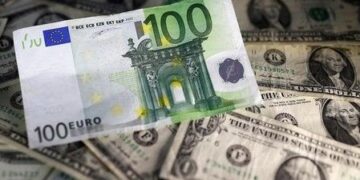By Joshua Kirby
Annual inflation eased for a second month in a row in the U.K., teeing up a new cut to interest rates as policymakers grow increasingly worried about the economic hit from U.S. President Trump’s changeable tariff policy.
The consumer-price index rose 2.6% in March from a year earlier, slowing from an annual rate of inflation of 2.8% in February, the U.K.’s Office for National Statistics said Wednesday. Inflation came in a little lower than economists had expected, according to a consensus of estimates compiled by The Wall Street Journal.
Annual services inflation, a key focus for policymakers at the Bank of England, meanwhile eased for the first time this year, reaching 4.7% from 5.0% in the first two months of 2025.
Inflation is still running higher than it has for most of the last year, underscoring the extent of the central bank’s challenge in taking inflation to its 2% target and keeping it there. The BOE since last year has cut interest rates at a slower pace than both the U.S. Federal Reserve and the European Central Bank, held back by the stronger price pressures affecting the British economy. The BOE expects inflation to begin to rise from April as a result of an increase in household energy prices, as well as higher payroll taxes and an increase in the national minimum wage.
While inflation is likely to pick up pace this month, the peak this year seems set to be lower than the 3.7% forecast by the BOE, Luke Bartholomew, deputy chief economist at investment firm Aberdeen, said.
“With the recent fall in energy prices and the stronger pound, the peak in inflation is now likely to be somewhat lower than the bank has been forecasting,” Bartholomew wrote in a note to clients. “An interest rate cut in May looks increasingly nailed on, and the path to more easing in the second half of the year is getting clearer.”
In the eurozone, inflation is also easing, hitting 2.2% in March and closing in on the ECB’s 2% target, according to figures Wednesday that confirm initial estimates for price inflation in the 20-member currency area. Core inflation similarly eased, suggesting underlying price pressures are benign enough to keep eurozone inflation low over the months ahead.
As annual inflation eases, the BOE’s focus is increasingly trained on the dangers to the domestic and global economy from Washington’s planned import tariffs, set out at the beginning of this month. The U.K., which doesn’t run a major surplus in its goods trade with the U.S., has largely avoided President Trump’s crosshairs.
But British exports are subject to Washington’s blanket 10% baseline tariff, as well as a separate 25% duty on cars and metals. The U.S. is the largest single export market for U.K. goods, and tariffs on British goods as well as indirect effects from a chillier global trade landscape could mean gross domestic product expanding 0.7% this year, compared with 1.5% in case tariffs weren’t implemented, according to calculations by the National Institute of Economic and Social Research, a think tank.
“We think a weak economy will quash inflation eventually and that the tariff shock has tilted the balance of risks toward lower inflation and faster falls in interest rates,” Ruth Gregory, an economist at consultancy Capital Economics, wrote.
While the hit to activity could cool inflation, some economists warn that tariffs could also drive prices higher if the U.K. government were to retaliate against U.S. measures or the pound were to weaken significantly.
How those forces interact is hard to judge at this point, BOE Deputy Gov. Sarah Breeden said.
“I would expect tariffs to lower economic activity,” she said. “But it’s too early to call the overall impact on inflation and hence the appropriate monetary policy response.”
Most investors expect the central bank to move to cut its benchmark rate by a quarter of a point to 4.25%, in what would be a fourth cut since summer.
Domestic pressures nevertheless remain within the BOE’s focus. Pay growth accelerated in the three months to February, data this week showed, keeping in relief the risk of a wage-price spiral that could make the bank more cautious about lower borrowing costs as the year progresses.
But for now the U.K. economy looks sluggish, Lindsay James, an investment strategist at Quilter, said.
“What this brings into play…is the scope for further rate cuts,” she said.
Write to Joshua Kirby at [email protected]; @joshualeokirby
(END) Dow Jones Newswires
04-16-25 0514ET















